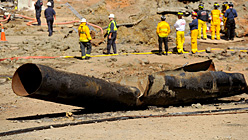…CPUC does audits. Now to what extent they actually go out and inspect pipes, I don’t know. They do, for the most part, paper audits.
Now PG&E has said in public settings in the last week, that they have now gone over every inch of transmission line between Milpitas and San Francisco– there are three of them. Now there are a couple of areas that are remote that they surveyed by helicopter but then they were going back in and surveying them on foot. And when they do that on foot, they go on foot, they walk the line with a measurement, an instrument that determines whether or not there is any leakage. I don’t know how frequently they really do that. But they’re supposed to do it twice a year. Is there someone at CPUC that’s watching them do that? I don’t know that either. Those are the kinds of questions that still have to be answered.
Richard Clark, Director of Consumer Protection and Safety, California Public Utility Commission:
(10 min. 48 sec.)
This sort of explosion is a highly anomalous event. There are tremendous precautions in place to make sure they don’t happen and they’ve not happened in the past. Most of the time when you see a gas line explode it’s because someone has damaged that pipeline by digging into it.
There’s a very rigorous regime of inspections required by the federal government, enforced by the state government, which require that internal corrosion, external corrosion be assessed, that any sort of defects or problem with the pipeline be detected. They’re inspected once a year with gas leak surveys, they’re inspected twice per year with patrol inspections, where people either walk or fly or drive by and look for grass that’s discolored or that sort of thing. The system is fundamentally safe. This is a highly anomalous event and it’s a huge mystery as to how it happened.
(12 min. 20 sec.)
Michael Krasny: Is it safe to say though that there are a lot of aging pipes in our infrastructure?
Richard Clark: There are a lot of aging pipes in the infrastructure, that’s true, but if they’re protected, they’re safe. And protection means that they’re coated with protective coatings, that they are cathodically protected such that the steel doesn’t do what it tries to do what it when it’s in the ground, which is turn back to iron and that they’re inspected so that any sorts of cracks or defects that occur from seismic activity, that occur from deterioration and that sort of thing, that they are inspected and detected.
Paul Rogers, environment reporter for the San Jose Mercury News and managing editor of QUEST, KQED’s science and environment series:
(13 min. 45 sec.)
…these incidents in the Bay Area are rare. What we’ve found is that there has been one fatality since 1986 and three injuries on Bay Area natural gas transmission lines. And there have been seven fatalities and 26 injuries from the distribution lines.
(14 min. 30 sec.)
And I think the questions that a lot of journalists and investigators are looking at right now, some of the key questions include, why did it take PG&E an hour and 46 minutes to shut off the gas. The manual valves of these pipes one is located underground, and under a manhole cover, the other is in a locked building. PG&E has said it could not get to them because of the fire. I’m not sure how the fire affects something that’s underground a mile away, but I guess that will come out.
And another key question includes, what role did the sewer pipe project that the city of San Bruno [worked on] in 2008, play in this, if any? They used a method underground that involved a lot of jarring and shaking of the soil to remove a pipe without digging up the street so NTSB has said they’re looking into that as well.
And I think the final question is the PUC gave a very strict order to PG&E to inspect all of the transmission lines by October 12. I’m curious what methodology they’re going to use and how rigorous that inspection’s going to be given the short amount of lines and the huge amount of lines.
Statement from PG&E:
We regret that we were not available to participate in today’s discussion with Michael Krosny (sic) about the San Bruno tragedy. We are optimistic that we will have the opportunity to do so in the future.
We continue to work with the community of San Bruno to restore the community and address their needs. Most recently, we announced the creation of the “Rebuild San Bruno Fund,” which will make available up to $100 million for the residents and city of San Bruno to help recover from last Thursday’s tragic event. The National Transportation Safety Board and other agencies continue their investigation to determine the cause of this event, and we are fully cooperating with the investigation.
